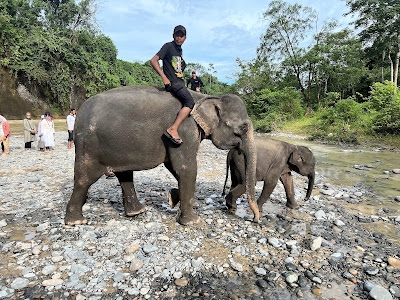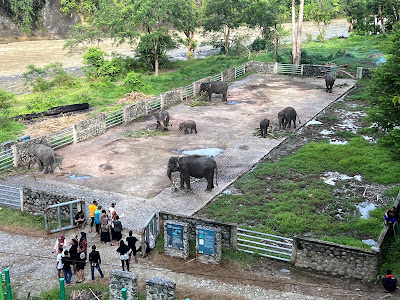The Republic of Indonesia is the fourth most populous country in the world (277,749,853 people) behind China (1,411,750,000 people), India (1,392,000 people), and the United States (335,167,000 people) and ahead of Pakistan (220,425,254). However, it is only the 14th largest country in terms of land area while the United States is third. Indonesia is 64th in population density per square mile (380) while the United States is 148th (91). Indonesia consists of more than 17,000 islands and has four of the 13 largest islands in the world (Borneo 4th with 288,868 square miles, Sumatra 6th with 171,068 square miles, Sulawesi 11th with 69,761 square miles and Java 13th with 53,589 square miles which are collectively called the Greater Sunda Islands). By comparison, Great Britain is 9th with 80,823 square miles.
The island of Sumatra is tropical, hot and humid. Tropical rain forest used to cover the island, but it has lost 50% of it in the last 35 years. The equator crosses Sumatra at its center (see the map below at 0 degrees). Medan, the largest city on Sumatra with a population of 2,435,252, is the fourth largest city in Indonesia and the largest outside of Java. It is located in the province of North Sumatra. Tangkahan is a 3 hour, 15 minute drive from Kuala Namu Int'l Airport outside Medan, which we flew into.
 |
| Malaysia is to the northeast and Java, just a portion of which is showing, is to the southeast. |
Many species that endeared me as a little boy to Sumatra are now critically endangered, including the Sumatran tiger, the Sumatran elephant, the Sumatran rhino and the Sumatran orangutan.
The jewel of Sumatra is the Gunung (Mount) Leuser National Park ("Gunung Leuser") which covers portions of North Sumatra and Aceh provinces. It is named after Mount Leuser, within the park boundary, which is 10,232 feet in elevation, and Gunung Leuser covers 4,925.6 square miles. It contains the largest wilderness area in Southeast Asia.
We planned our trip with Adventure Indonesia and I'd let them know I wanted to visit Gunung Leuser by the town of Bukit Lawang because I'd read that was the best place to see Sumatran orangutans in the wild. I'd also indicated that I wanted to see Sumatran elephants and Adventure Indonesia recommended a a day in Tangkahan to see them. They booked us in the Jungle Lodge in Tangkahan and I read that it had a river next to it and was in a beautiful setting. I looked up Tangkahan on-line and found it was just a 50 minute drive northeast of Medan, nowhere near Gunung Leuser. I imagined it as less rural with less opportunity to see wildlife than Bukit Lawang. So imagine my surprise when we got to Sumatra and I learned it was a 3 to 4 hour drive to Tangkahan and when we got to Tangkahan that Gunung Leuser was just across the river. I couldn't square that with what I'd learned previously and it was only in preparing for this post that I discovered there were two Tangkahans, the one by Medan and the one by Gunung Leuser.
Audley Travel notes that Tangkahan is a small rural village on the edge of Gunung Leuser that is more isolated than Bukit Lawang and less developed. If I'd known it was next to Gunung Leuser and that it was more isolated than Bukit Lawang, before going there, I would have had a completely different perception going in. It was not until we got to Bukit Lawang, later, that I was surprised by the much more substantial and commercial town and a reversal of thoughts between the two towns started to stir in my mind.
The first thing we did when we got to Tangkahan was go to see the Sumatran elephants. They are captive and kept next to the Batang River near the confluence with the Bulah (Bamboo) River. We crossed over a very long bridge over the Batang and walked down to the Batang where the elephants, nine in all (seven adults and 2 babies) were in and next to the river.
 |
| The bridge over the Batang River. |
 |
| Elephants seen from the bridge in the river. |
We had an opportunity to wash them with scrub brushes, touch them and feed them bananas and sugar cane. They sprayed us with water from their trunks and used their trunks to try and get bananas and sugar cane from us. Until Covid the elephants were giving humans jungle rides and that has been stopped. The washing and feeding has continued.
 |
| I loved the large male elephant with tusks and had an opportunity to feed it and feel its trunk. |
 |
| Judy and I had an opportunity to wash and feed a mother and baby. |
 |
| After finishing at the river, the elephants were led to a large enclosure where their legs were chained and they were given additional food. |
After finishing with the elephants we walked the bridge back over the Batang.
 |
| The elephants in the enclosure as seen from the bridge. |
We drove to the Jungle Lodge which required another walk over a long bridge over the Batang and then a fairly lengthy walk to a building overlooking the Bulah River, a short distance above the confluence with the Batang. We were given a room overlooking the Bulah where we saw Southeast Asian water monitors in and near the river.
We only had electricity during the evening at the Jungle Lodge to power our electric ceiling fan, cold water for a shower and a very nice meal that we could choose from a fairly extensive menu.
The next morning we were taken by a local guide on a hike. We walked on the hill above the Bulah a ways toward the Batang and then started to walk down to the Bulah. Our guide pointed out long-tailed macacques jumping from a large tree on the far side of the Bulah, over the Bulah and landing in a tree on our side. After several jumped I was able to get the camera ready and got some decent photos of one of the macacques mid-air on a jump.
 |
| Flying across the water through the air. |
 |
| Landing in a tree and grabbing hold. |
At the Bulah we removed our shoes, walked barefoot across the river, then put our shoes back on. We began a trek up the side of a relatively steep trail into an extremely dense rain forest. It had rained during the night and the vegetation was soaking wet. Not too far into our hike our guide spotted some monkeys in the trees. I did not get great views of them and was only able to identify them when I got home. I couldn't understand our guide's English. We saw the same kind of monkey the next day near Bukit Lawang, Thomas leaf monkeys or Thomas's langur. We watched them quite awhile, climbing through the wet vegetation to get close and get better shots.
 |
| Thomas leaf monkey or Thomas's langur. |
We continued our hike up the side of the mountain and we could hear gibbons whooping away further up the mountain, although they sounded pretty close. I believe they were Sumatran white-handed gibbons. Our guide said we would need to hike to the top of the mountain and he knew I didn't have it in me. I was sweating profusely from every pore in the muggy heat.
Our guide pointed out leaches on our legs and hands. They are found on wet leaves and jump onto people. They are thin and tiny, then latch onto a human and start sucking out blood, but you can't feel them. When they get enough blood they get engorged and quite large. We both got a number of them on us and Judy found one that had found its way through a vent in my shirt and was attached below my armpit. When I got back to the Jungle Lodge later that day I had about five large bloodstains on my shirt from the leeches. If you wash off the blood it just keeps bleeding. You have to let the suck sites coagulate and leave them alone or they keep bleeding for days. I was not pleased that our guide did not recommend that we pull up our socks over our trouser legs to help prevent the leaches from getting on our legs. We saw that as common practice among the guides near Bukit Lawang and I believe our Tangkahan guide did it as well.
During our hike we crossed a number of small streams and heard more gibbons, but saw no more wildlife. Our guide pointed out many trees and plants, many of them used for medicinal purposes by the locals. We eventually made our way back down the mountain to the side of the Bulah where another guide had a wonderful lunch spread out for us at the side of the river, including fruit, sandwiches and chicken. After lunch we crossed over the Bulah in bare feet and eventually back to the Jungle Lodge where we showered, packed and started our drive to Bukit Lawang.
Our guide told us that they sometimes see orangutans and that he has seen one wild elephant in the jungle. The Sumatran elephants are extremely rare and the captive elephants are the only reasonable way to see them.



















Great info about the relative size and population of the Indonesian islands. This day was a physically challenging introduction to our Indonesian adventure, but it was fun to bathe the elephants and our lunch set up in and on the side of the river was a blast. I could have done without the leeches. That was a never-to-be-forgotten experience that will haunt my nightmares for years to come.
ReplyDelete